Bitcoin
Bitcoin to $250K? Hayes Links Price Surge to Fed’s QE Move

Arthur Hayes, former CEO of BitMEX, has predicted that Bitcoin (BTC) could soar to $250,000 by the end of the year.
However, this prediction is contingent on the US Federal Reserve (Fed) shifting its monetary policy toward Quantitative Easing (QE).
Bitcoin to $250,000, Hayes Predicts
Hayes argues that a halt in Quantitative Tightening (QT) and a return to liquidity injections would trigger a substantial Bitcoin rally.
“If my analysis regarding the interplay of the Fed, Treasury, and banking system is correct, then Bitcoin hit a local low of $76,500 last month, and now we begin the ascent to $250,000 by year-end,” read an excerpt in his latest blog.
This prediction hinges on his belief that central banks, particularly the Fed, will be forced to intervene to support financial markets, ultimately driving Bitcoin higher.
Further, the BitMEX co-founder directly ties Bitcoin’s potential price movement to the Fed’s approach to monetary policy. He argues that the central bank’s response to mounting fiscal pressures will lead to an end of QT and a de facto return to QE.
“Powell proved last week that fiscal dominance is alive and well and that he will do whatever it takes to ensure the Treasury can fund itself at reasonable rates. Therefore, I am confident QT, at least regarding treasuries, will stop in the short to medium term,” Hayes added.
Based on these, Arthur Hayes sees this as a pivotal moment for Bitcoin, emphasizing that the pioneer crypto would “scream higher once this is formally announced.”
Hayes also reinforced his confidence in the prediction, stating that his Bitcoin target is attainable as the bond market, banks, and Congress (which he terms BBC) will pressure the Fed into action.
British financial expert Raoul Pal supports the thesis of a bullish outlook for Bitcoin price. The former Goldman Sachs executive pointed to macroeconomic indicators that suggest a Bitcoin rally is imminent.
Raoul Pal shared a chart correlating the global M2 money supply and Bitcoin’s price. Based on history, Bitcoin tends to rise around 10 weeks after M2 increases, with Pal’s analysis suggesting that Bitcoin may soon enter a bullish phase.
“The waiting game is almost over…the 10-week lead is my preferred… but,” Pal remarked.
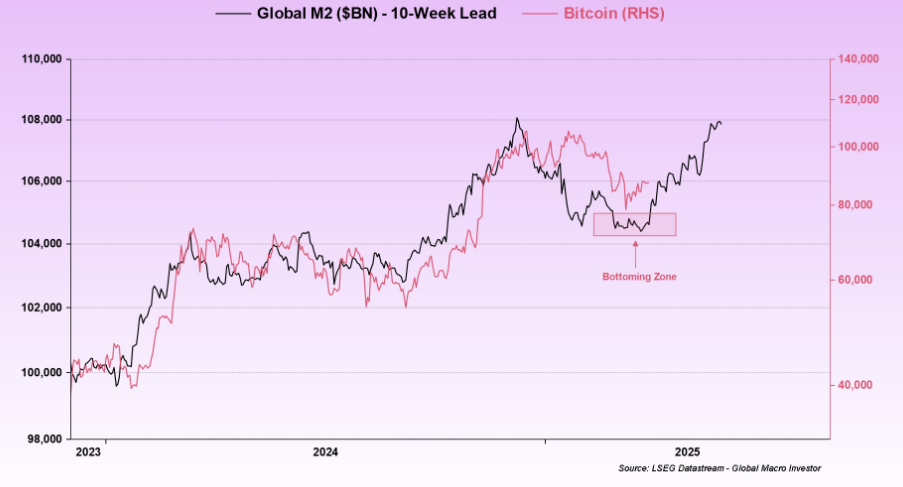
QCP Capital’s Stagflation Warning
Adding another layer to the macroeconomic picture, analysts at QCP Capital warn that if stagflation takes hold, the Fed could lean toward hiking rates instead of cutting them. Such an action would complicate the bullish outlook for Bitcoin.
“Markets continue to price 2.5 cuts in 2025. The Fed finds itself in a tight corner with consumer confidence and soft data coming in weak which may portend weaker GDP in Q2. At the same time, tariff-induced inflationary pressures could start building after April 2,” the analyst wrote.
The optimism comes despite Bitcoin logging its worst first quarter (Q1) performance in seven years. This notwithstanding, analysts point to a bullish momentum, suggesting that a price recovery is on the horizon.
“Sellers have dried up, and buyers seem comfortable with current price levels – setting the stage for a structural supply shortage. April-May could turn into a consolidation zone – a calm before the next impulse,” stated market analyst Axel Adler Jr.
Veteran investors are also increasing their Bitcoin holdings, signaling a phase of accumulation that often precedes strong price rallies. Market data also indicates that declining selling pressure from Bitcoin holders is paving the way for a potential push toward $90,000.
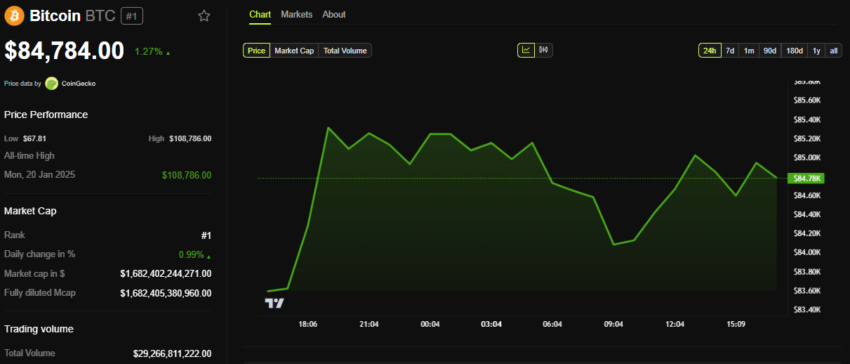
Meanwhile, Standard Chartered has noted Bitcoin’s growing role as an inflation hedge. This further solidifies the pioneer crypto’s place as a macroeconomic asset in uncertain financial times.
Nevertheless, as macroeconomic concerns continue challenging Bitcoin’s attractiveness, Gold is progressively presenting as an alternative store of value. BeInCrypto also reported that gold is outshining Bitcoin as a haven amid Trump’s 2025 tariff chaos.
Disclaimer
In adherence to the Trust Project guidelines, BeInCrypto is committed to unbiased, transparent reporting. This news article aims to provide accurate, timely information. However, readers are advised to verify facts independently and consult with a professional before making any decisions based on this content. Please note that our Terms and Conditions, Privacy Policy, and Disclaimers have been updated.
Bitcoin
US Trade Tariffs Trigger $240 Million Crypto Outflows Last Week

Crypto ETPs (exchange-traded products) saw a significant setback last week, as outflows reached $240 million.
The turnout follows escalating trade tensions in the US, sparking investor caution amidst President Donald Trump’s sweeping new import tariffs.
Crypto Outflows Hit $240 Million Last Week
According to the latest CoinShares report, crypto outflows totaled $240 million last week, primarily driven by fears that trade disruptions could stall global growth.
“Digital asset investment products saw outflows totaling $240m last week, likely in response to recent US trade tariff news that poses a threat to economic growth,” CoinShares’ James Butterfill noted.
Bitcoin alone accounted for $207 million of the outflows, significantly denting its year-to-date (YTD) inflow volume, which now stands at $1.3 billion.
Ethereum products also suffered, posting $37.7 million in outflows. Solana and Sui followed with $1.8 million and $4.7 million, respectively.
This marks a sharp reversal from the previous week’s report, which had seen $18 million in altcoin inflows, ending a four-week losing streak.

The shift in sentiment reflects deepening investor uncertainty across all asset classes. While the sell-off was widespread, the US led the outflows with $210 million. This supports the argument that President Trump’s tariffs contributed to the growing market uncertainty.
BeInCrypto reported that Trump plans reciprocal tariffs. The plan, announced as part of the president’s “America First” trade agenda, includes two key components. The first was a baseline 10% tariff on all imports into the US starting April 5, affecting nearly all trading partners.
Second, higher “reciprocal” tariffs, ranging from 11% to 50%, will target specific countries with significant trade surpluses with the US or high barriers to American goods. These escalated rates, affecting around 57 to 90 countries, will start on April 9.
In this regard, China faces a 34% reciprocal tariff on top of an existing 20% tariff, totaling 54%. Meanwhile, the European Union faces 20%, Japan 24%, and Vietnam up to 46%.
Against this backdrop, local media reported that China called out the US for economic bullying.
“China accuses the US of unilateralism, protectionism, and economic bullying with tariffs,” analyst Jackson Hinkle remarked.
US Bitcoin ETFs See $172 Million in Outflows.
Meanwhile, institutional retreat was most evident in the US spot Bitcoin ETF (exchange-traded fund) market. These financial instruments posted $172.89 million in net outflows last week, ending a two-week inflow streak that had added nearly $941 million.
According to data from SoSoValue, most redemptions occurred across four of the five trading days, reflecting the scale of investor unease.

Data on Farside Investors corroborates the outlook, showing Grayscale’s GBTC led the pack with $95.5 million in outflows, followed by WisdomTree’s BTCW at $44.6 million.
Other ETFs, including BlackRock’s IBIT, Bitwise’s BITB, ARK 21Shares’ ARKB, and VanEck’s HODL, reported redemptions ranging from $4.9 million to $35.5 million.
Despite a strong mid-week inflow of $220.76 million on April 3, it was not enough to counter the heavy losses sustained on other days. Monday through Friday saw consistent outflows, with Tuesday alone recording $157.64 million in redemptions.

Ethereum ETFs were also not spared, marking six consecutive weeks of outflows totaling nearly $800 million since February. Last week alone, Ethereum funds saw $49.93 million in redemptions, reinforcing the narrative of widespread risk aversion.
Still, some bright spots emerged. Franklin Templeton’s EZBC, Fidelity’s FBTC, and Grayscale’s newer spot, Bitcoin Trust, collectively saw $61.8 million in inflows. This suggests selective institutional interest remains.
CryptoQuant CEO Ki Young Ju addressed the broader panic, emphasizing that institutional flows still rely heavily on on-chain settlements.
“Dismissing on-chain data due to paper Bitcoin is misguided; it’s essential for understanding market supply and demand dynamics,” he said on X (Twitter).
As the second week of Q2 begins, investors monitor whether the pullback represents a temporary correction. According to Standard Chartered Bank, Bitcoin could rebound as early as Friday. Meanwhile, sentiment suggests it could start a deeper structural shift in crypto’s institutional narrative.
Disclaimer
In adherence to the Trust Project guidelines, BeInCrypto is committed to unbiased, transparent reporting. This news article aims to provide accurate, timely information. However, readers are advised to verify facts independently and consult with a professional before making any decisions based on this content. Please note that our Terms and Conditions, Privacy Policy, and Disclaimers have been updated.
Bitcoin
Bitcoin Drop Hits Companies Holding Digital Assets Hard

Public companies are grappling with mounting losses from their Bitcoin (BTC) reserve strategies as the cryptocurrency’s value plunges.
This comes as BTC dropped below $80,000, sparking renewed debate over the risks of corporate investments in digital currencies.
Are Bitcoin Reserve Strategies Backfiring for Companies?
The week opened on a grim note for the cryptocurrency market, with many referring to it as a “Black Monday.” According to BeInCrypto data, Bitcoin saw a sharp decline of 9.6% in the past 24 hours, falling to $75,089 at the time of writing.

The liquidation figures have been equally staggering. According to Coinglass, Bitcoin experienced the highest liquidations in the same timeframe, totaling $474 million. Of that, $405.7 million came from long liquidations, while $68.2 million was from short liquidations.
Importantly, companies holding Bitcoin reserves have not been spared from the recent market bloodbath. Many now face significant unrealized losses amid Bitcoin’s sharp downturn.
According to data from Bitcoin Treasuries, the NGU ratio, which measures the difference between the current Bitcoin value and the cost basis of a company’s holdings, has turned red for many firms.
This indicated that the current market price of Bitcoin is now below the acquisition cost for many institutional investors. For example, Metaplanet (3350.T) is experiencing a 12.4% unrealized loss on its Bitcoin holdings. The company currently holds 4,206 Bitcoins, valued at approximately $314.7 million, with an average cost per Bitcoin of $85,483.
Similarly, The Blockchain Group’s (ALTBG.PA) portfolio is down 14.4%. Holding 620 Bitcoins valued at $46.39 million, the company’s average cost per Bitcoin is $87,424.
Semler Scientific (SMLR) has also felt the impact, with a 14.7% loss on its portfolio. The company holds 3,192 Bitcoins valued at $238.9 million, with an average cost of $87,850 per Bitcoin.
Even Strategy (MSTR), an early player in corporate Bitcoin adoption, is facing challenges. Since beginning its Bitcoin acquisition in August 2020, the company has accumulated 528,185 Bitcoins, valued at $39.5 billion, with an average cost of $67,485 per Bitcoin, resulting in an overall profit of 10.9%.
However, data from SaylorTracker reveals that all Bitcoin purchased by the firm since November 2024 is currently at a loss. These acquisitions were made at prices ranging from $83,000 to as high as $106,000 per Bitcoin.
Meanwhile, the decline in Bitcoin’s value has had a significant ripple effect on the firms’ stocks. 3350.T saw a sharp 20.2% drop in its stock price, while ALTBG.PA experienced a 15.8% decline.
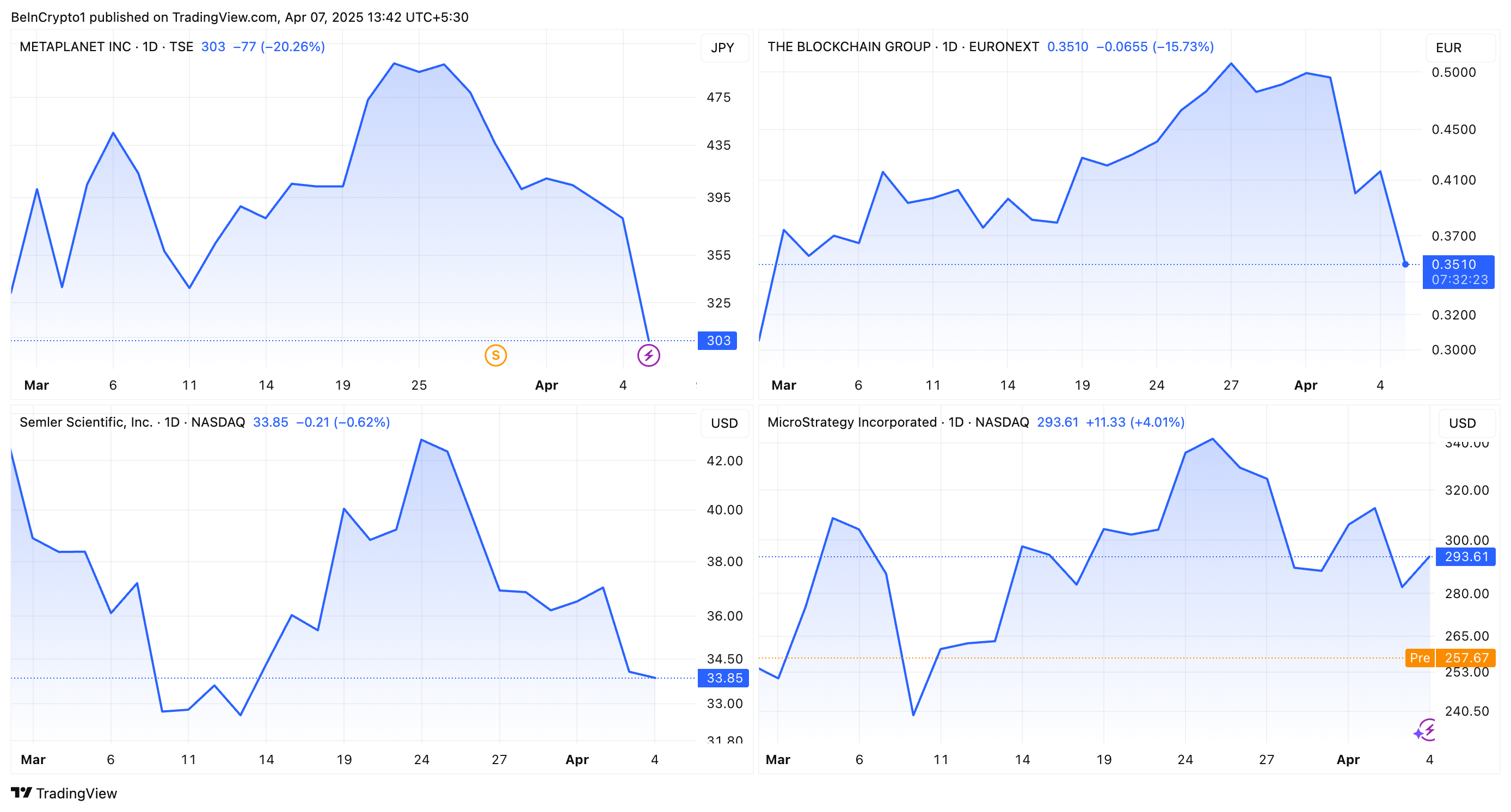
SMLR experienced a smaller 0.6% dip but still reflected the broader market trend. Lastly, MSTR dropped 11.2% in pre-market trading despite some initial resilience.
Amid this market crash, Peter Schiff, economist and long-time Bitcoin skeptic, took aim at Strategy.
“Attention Saylor, now that Bitcoin is below $80,000, if you want to prevent it from crashing below your average cost of $68,000, you had better back up the truck with borrowed money today and go all in,” he posted on X.
The economist further predicted that the company’s Bitcoin strategy could lead to its downfall.
“It will end with the bankruptcy of MSTR,” Schiff stated.
He also questioned Bitcoin’s value as a safe haven asset. Schiff stressed that the coin’s substantial decline compared to other assets makes it an unreliable store of value, especially during market selloffs.
Disclaimer
In adherence to the Trust Project guidelines, BeInCrypto is committed to unbiased, transparent reporting. This news article aims to provide accurate, timely information. However, readers are advised to verify facts independently and consult with a professional before making any decisions based on this content. Please note that our Terms and Conditions, Privacy Policy, and Disclaimers have been updated.
Bitcoin
5 US Economic Events With Crypto Market Implications This Week

Five key US economic indicators could influence Bitcoin (BTC) sentiment this week amid heightened bearish sentiment in the crypto market.
The influence of US economic events and policies on Bitcoin and crypto in general continues to grow. This makes the anticipated data points particularly important for traders and investors.
US Economic Data To Watch This Week
Amid the crypto black Monday woes, this week’s US economic data will be crucial for Bitcoin and altcoin markets.
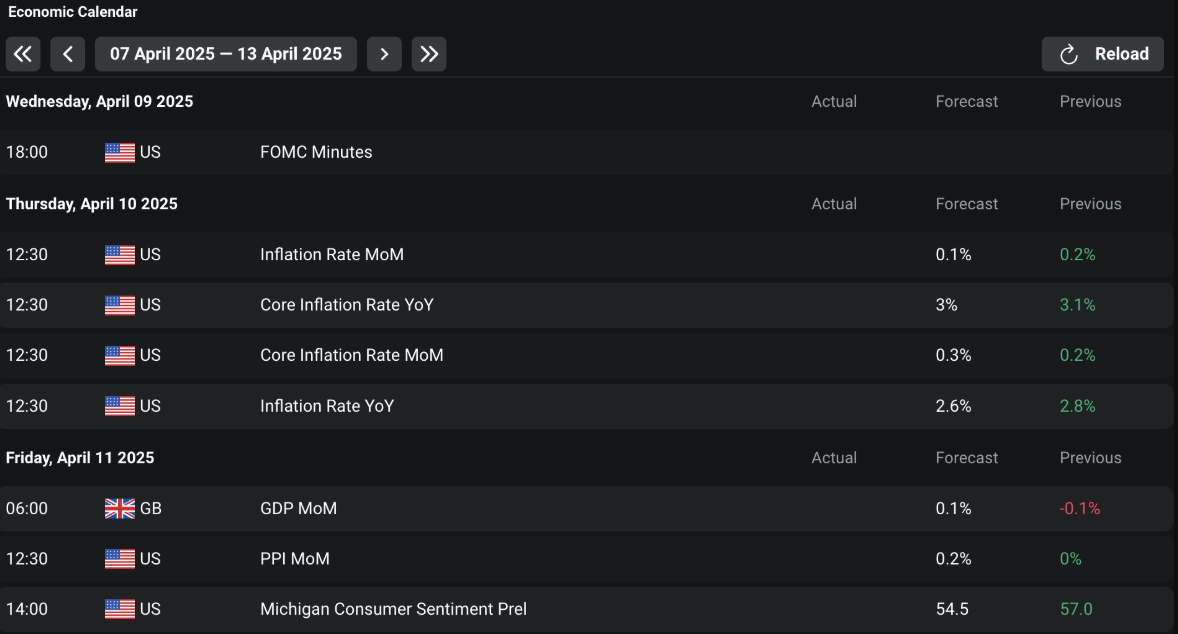
March FOMC Minutes
The Federal Open Market Committee (FOMC) minutes from the March meeting are due on Wednesday. This US economic indicator will offer traders and investors a window into the Federal Reserve’s (Fed) monetary policy direction.
These minutes detail discussions on interest rates, inflation, and economic growth, influencing market sentiment. If the tone is hawkish, suggesting tighter policy or fewer rate cuts, Bitcoin could face downward pressure as investors favor safer assets like bonds, bolstered by a stronger US dollar.
Conversely, a dovish outlook hinting at rate cuts could boost risk appetite, driving capital into crypto. This would come as cheaper borrowing encourages investment in high-growth assets.
Based on these, crypto traders will watch for clues about the Fed’s stance on inflation. This is more so considering recent data showed no significant re-acceleration.
Fed Chair Jerome Powell could reaffirm previous comments about resisting premature rate cuts, or new signals might emerge. Given Bitcoin’s sensitivity to liquidity, any unexpected pivot could spark volatility.
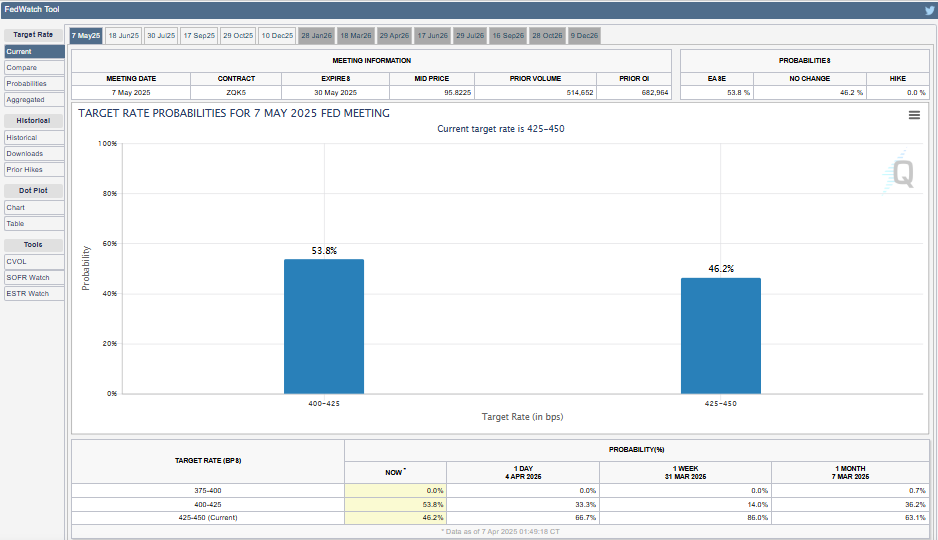
Traders and investors should brace for short-term price swings, particularly if the minutes deviate from market expectations priced in by the CME FedWatch.
JPMorgan is the first Wall Street bank to forecast a US recession following Trump’s tariffs. According to the bank, the FED might be forced to cut rates before the next meeting. Notably, the next FOMC meeting after the April 9 minutes will be May 6-7, 2025.
Despite JPMorgan’s fears and urges, the ongoing crypto market bloodbath notwithstanding, no emergency meetings are announced for April as per the Fed’s official calendar. Accordingly, the next likely date for any policy changes, like the rate cut JPMorgan mentioned, is May 6-7.
“The next FOMC meeting is on the first week of May, can investors wait? Can US people wait? How high is current inflation? Can we have an urgent rate cut meeting? Until China enters crypto, BTC still depends on US liquidity,” one user noted.
Initial Jobless Claims
Beyond the March FOMC minutes, the next US economic indicator for crypto traders to watch is the Initial Jobless Claims. Due every Thursday, this report provides crypto market participants with a real-time snapshot of US labor market health. This makes it a key driver of economic stability.
Measuring new unemployment filings, lower claims would signal a strong economy, while higher claims indicate weakness.
For crypto, a strong labor market (fewer claims) might dampen Bitcoin’s appeal as investors lean toward traditional equities. However, rising claims could fuel recession fears, prompting the Fed to consider rate cuts. Historically, this has been a boon for crypto, as lower rates make borrowing cheaper and increase liquidity.
Traders will, therefore, monitor whether claims exceed the previous week’s 219,000. Such an outcome would boost Bitcoin as a hedge against economic uncertainty.
Meanwhile, recent trends show claims have been declining. However, rising continuing claims suggest that job-finding challenges persist.
Crypto volatility could spike if the data surprises, especially alongside Thursday’s interplay, with the CPI release coming shortly afterward.
“US Core Inflation Rate and CPI (Thu10) and Initial Jobless Claims (Thu10) are top-tier market movers, likely impacting USD, bond yields, and Fed rate expectations amid tariff uncertainties,” one user noted.
US CPI
The Consumer Price Index (CPI), which will be released on Thursday, is another critical US economic indicator for crypto market participants to watch. The data measures inflation through changes in consumer goods and services prices.
A higher-than-expected CPI could signal persistent inflation, potentially leading the Fed to maintain or raise rates. This would strengthen the dollar and pressure crypto prices downward as risk assets lose appeal.
The previous CPI data showed inflation cooled to 2.8% in February. If March’s CPI exceeds the anticipated 2.6% annual rise, Bitcoin might dip as investors pivot to inflation-resistant assets.
Conversely, a lower CPI could reinforce expectations of rate cuts, boosting crypto as a store of value amid easing monetary policy.
Crypto traders will also focus on core CPI (excluding food and energy) for a clearer inflation trend, as it heavily influences Fed decisions.
Given Bitcoin’s April performance dropping below $75,000, this data could dictate its next move. Volatility is almost certain, so participants must be ready for market reactions, especially as FOMC minutes will still be fresh in mind.
US PPI
Friday’s Producer Price Index (PPI) tracks inflation at the wholesale level. This US economic indicator offers crypto market participants insight into production costs that could trickle down to consumers.
Rising PPI suggests higher input costs, like energy or hardware, which are crucial for crypto mining. This could squeeze miner profitability and reduce Bitcoin supply growth.
If March’s PPI climbs significantly above 3.3% year-over-year, it might signal brewing inflationary pressure. This could prompt a Fed tightening bias that could weigh crypto prices as liquidity tightens.
Conversely, a softer PPI might ease inflation fears, supporting a bullish crypto outlook if paired with dovish Fed signals on Wednesday.
Crypto investors should note PPI’s lead indicator status for CPI. A stark divergence from Thursday’s CPI could confuse markets and heighten volatility.
“Massive macro week ahead FOMC minutes, CPI, and PPI. A battleground for rate cut bets,” Deribit noted.
With Bitcoin sensitive to dollar strength, participants should watch how PPI shapes Fed expectations. A balanced reading might stabilize sentiment, but surprises could trigger sharp moves.
Consumer Sentiment
The University of Michigan’s Consumer Sentiment Index, released Friday, will reflect US consumers’ economic confidence. This is a vital signal for crypto market participants.
A high reading indicates optimism, potentially spurring spending and risk-taking, which could lift Bitcoin as investors seek growth assets. Strong sentiment might also reduce recession fears, indirectly supporting crypto by maintaining market liquidity.
However, a drop below expectations of 54.5 could hint at inflation or job worries, denting risk appetite. This could push funds toward safer havens, pressuring crypto prices. This index often embeds inflation expectations, such that Bitcoin’s hedge narrative could strengthen if consumers anticipate rising prices.
These events collectively shape the crypto market sentiment this week, intertwining monetary policy, economic health, and investor psychology.
Participants must stay agile and blend data insights with market reactions to develop informed strategies. They must also conduct their own research.
Disclaimer
In adherence to the Trust Project guidelines, BeInCrypto is committed to unbiased, transparent reporting. This news article aims to provide accurate, timely information. However, readers are advised to verify facts independently and consult with a professional before making any decisions based on this content. Please note that our Terms and Conditions, Privacy Policy, and Disclaimers have been updated.
-

 Bitcoin24 hours ago
Bitcoin24 hours agoUS Macro Setup To Favour New Bitcoin ATH In The Long Run
-

 Ethereum23 hours ago
Ethereum23 hours agoEthereum Lags Behind Bitcoin In Q1 Performance Amid Market Downturn – Details
-

 Altcoin21 hours ago
Altcoin21 hours agoExpert Reveals Decentralized Strategy To Stabilize Pi Network Price
-

 Market20 hours ago
Market20 hours agoBitcoin Price Drops Below $80,000 Amid Heavy Weekend Selloff
-

 Ethereum19 hours ago
Ethereum19 hours agoEthereum Supply On Exchanges Plummets – Is A Supply Squeeze Coming?
-

 Market23 hours ago
Market23 hours ago3 Token Unlocks for This Week: AXS, JTO, XAV
-

 Market11 hours ago
Market11 hours agoSolana (SOL) Freefall—Can It Hold Above The $100 Danger Zone?
-

 Market7 hours ago
Market7 hours agoEthereum Price Tanks Hard—Can It Survive the $1,500 Test?

















